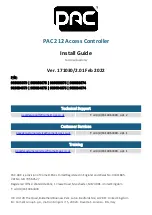UM10208_2
© NXP B.V. 2007. All rights reserved.
User manual
Rev. 02 — 1 June 2007
56 of 362
NXP Semiconductors
UM10208
Chapter 7: LPC2800 CGU
The state of the LPMBYP and LPDBYP bits determine the operating mode of the Main
PLL, as described in
.
3.3 Main PLL example
Suppose that the fast oscillator is 12 MHz and you want the main PLL to run at 60 MHz.
Program the main PLL registers as follows:
•
leave the LPFIN register 0001 as at reset, to use the fast oscillator,
•
write 4 to LPMSEL, which makes the PLL output clock 12MHz x (4+1) = 60 MHz,
•
write 1 to LPPSEL, which causes the PLL CCO frequency to be 4 x 60M = 240 MHz
(the center frequency of the CCO operating range),
•
write 0 to LPPDN, to start the main PLL,
•
read LPLOCK repeatedly until it is 1, indicating that the main PLL has started,
•
program one or more selection stages to use the main PLL as their clock input.
LPDBYP
Divisor Bypass Register
. When bit 0 of this register
is 1, the Post Divider is not used.
R/W
0
0x8000 4CF4
LPMSEL
Multiplication Factor.
If LPMBYP is 0, program this
5-bit register to get the desired output clock: F
CLKOUT
= F
CLKIN
* (1).
R/W
0
0x8000 4CF8
LPPSEL
Division Factor.
If LPDBYP is 0, program this 2-bit
register so that
160 MHz
≤
F
CLKOUT
* 2
(1)
≤
320 MHz
Note that 2
(1)
= 2, 4, 8, or 16.
R/W
0
0x8000 4CFC
Table 38.
Main PLL Operating Modes
LPMBYP LPDBYP Operation
0
0
Normal Mode.
The PLL output clock (clkout) is the selected input clock
multiplied by (1). The post divider is used, and the FCCO
frequency is F
CLKOUT
* 2
(1)
, which must be between 160 and 320
MHz.
0
1
Divisor Bypass Mode.
The PLL output clock (clkout) is the selected input
clock multiplied by (1), but the post divider is not used. This
means that F
CLKOUT
must be between 160 and 320 MHz. This is too fast to
operate many LPC288x modules: a fractional divider can be used to scale
the clock down to a usable rate.
1
0
Multiplier Bypass Mode.
The PLL output clock is the selected input clock
divided by 2
(1)
. This could be used to save power when the LPC288x
is in a relatively inactive mode, and the conditions for resuming normal
operation are more complex than can be indicated by the Event Router’s
Wakeup facility.
1
1
Total Bypass Mode.
The PLL output clock is the selected input clock. This
is a useless mode because the selected input clock is always an alternative
to the PLL output clock.
Table 37.
Main PLL registers
Name
Description
Access Reset
value
Address


















